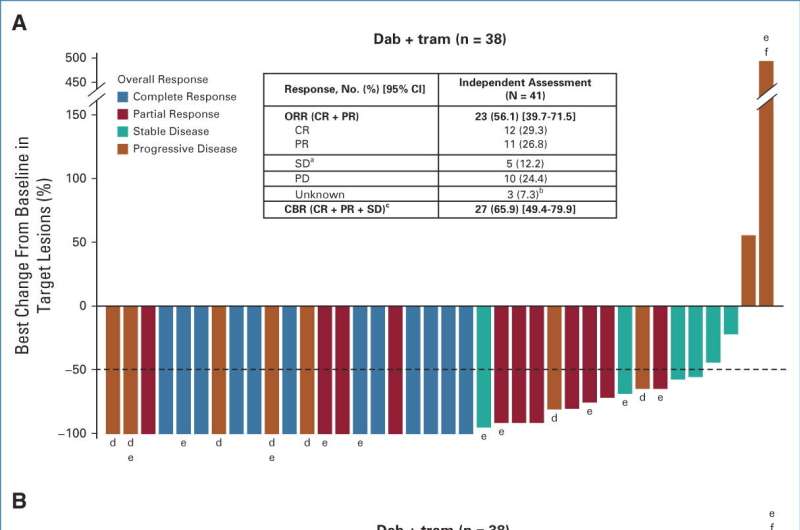This article has been reviewed according to Science X's editorial process and policies. Editors have highlighted the following attributes while ensuring the content's credibility:
fact-checked
peer-reviewed publication
trusted source
proofread
Clinical trial results give new hope for children with rare gliomas

A collaboration of researchers, led by UCL and Great Ormond Street Hospital, have published successful results from a Phase II clinical trial for the treatment of BRAF mutated low-grade pediatric gliomas.
Gliomas are cancerous brain tumors that start in glial cells—the supporting cells of the brain.
The results from the TADPOLE-G study, published in the New England Journal of Medicine and the Journal of Clinical Oncology, are the first to demonstrate a clear clinical benefit of combining the therapies of Dabrafenib and Trametinib (Novartis) in BRAF mutated low- and high-grade pediatric gliomas respectively.
For children with pediatric low-grade gliomas, the normal course of treatment is a full surgical removal. However, for children where this is not possible, additional treatments like chemotherapy are required. These patients often experience multiple relapses, further disease progression and serious side effects.
In the randomized trial, 73 children with BRAF-mutated low-grade gliomas (BM-LGG) were treated with Dabrafenib and Trametinib. Their outcomes were compared to 37 patients who were treated with standard chemotherapy drugs.
Researchers found that the combination therapy lessened chemotherapy side effects, it also improved overall response rate by over four-fold and increased median progression-free survival from 7.4 months with chemotherapy to 20.1 months with the new treatment.
The new research follows on from the publication of results from the same study in patients with BRAF-mutated high-grade gliomas (BM-HGG).
Children with high-grade gliomas often undergo full surgical resections, followed by radiotherapy and chemotherapy. Unfortunately, overall, less than one in five children respond well to treatment and two-year survival is less than 35%, with many patients' cancer returning.
Forty-one children who had previously received treatment for their BM-HGG took part in the second study. The treatment led to 56% of patients responding to treatment overall—a significant improvement compared to previous chemotherapy trials—and a median duration of response of 22.2 months.
The study leaders say that these trials demonstrate a clear clinical benefit of the dual treatment, with the recommendation being that it become a first-line treatment for BM-LGG and a clinical option for those with relapsed/refractory BM-HGG.
Evidence from these trials is now being used as part of a NICE scoping review to appraise the clinical and cost-effectiveness of the treatments. The US Food and Drug Administration have already approved the treatment for children with low-grade glioma.
Professor Darren Hargrave (UCL Great Ormond Street Institute of Child Health and GOSH), said, "The results of these studies highlight how targeted drug therapies can offer patients new treatment avenues that not only improve outcomes but reduce the side effects often associated with cancer therapies."
Mutations in the BRAF gene were first identified as drivers of cancer in the early 2000s and now targeted therapies such as Dabrafenib and Trametinib are being used to treat melanoma and non-small cell lung cancer in patients with mutations in the BRAF gene.
The BRAF mutation is present in around 15%–20% of pediatric low-grade gliomas and around 5%–10% of high-grade gliomas in children. These studies are the first to investigate the effectiveness of the combination therapy in pediatric gliomas.
Professor Hargrave chaired the TADPOLE-G Clinical Trial Steering group and led recruitment at GOSH for both this trial and the earlier Phase I arm of the trial.
He said, "It has been incredible to watch research move our ability to treat specific cancers forward at such a rapid pace. I was involved in the original study that identified BRAF gene mutations as drivers of cancer and so it has been fantastic to now be able to see treatments that target the mutation in clinical trials for pediatric gliomas.
"These studies demonstrate the power of collaborative, global research to find new treatments for rare cancers. We'd like to thank all the patients and families who make research like this possible."
Pediatric gliomas, although the most common type of brain tumor, are still rare, especially when divided into specific molecular subtypes such as BRAF-mutated tumors. Global collaboration is therefore essential to achieve timely and scientifically significant results, which led the TADPOLE-G study to enroll patients from 58 sites in 20 countries.
Gerrit Zijlstra, Chief Medical Officer, Novartis UK, said, "New treatments that help improve outcomes and reduce side effects for young patients living with BRAF V600 low- and high-grade gliomas address unmet patient need, where treatment options are very limited.
"We welcome the results of the TADPOLE-G clinical trial and are humbled to be a part of an international scientific community effort in developing targeted therapies based on the unique genetic features of a patient's tumor."
More information: Eric Bouffet et al, Dabrafenib plus Trametinib in Pediatric Glioma with BRAF V600 Mutations, New England Journal of Medicine (2023). DOI: 10.1056/NEJMoa2303815
Darren R. Hargrave et al, Phase II Trial of Dabrafenib Plus Trametinib in Relapsed/Refractory BRAF V600–Mutant Pediatric High-Grade Glioma, Journal of Clinical Oncology (2023). DOI: 10.1200/JCO.23.00558


















